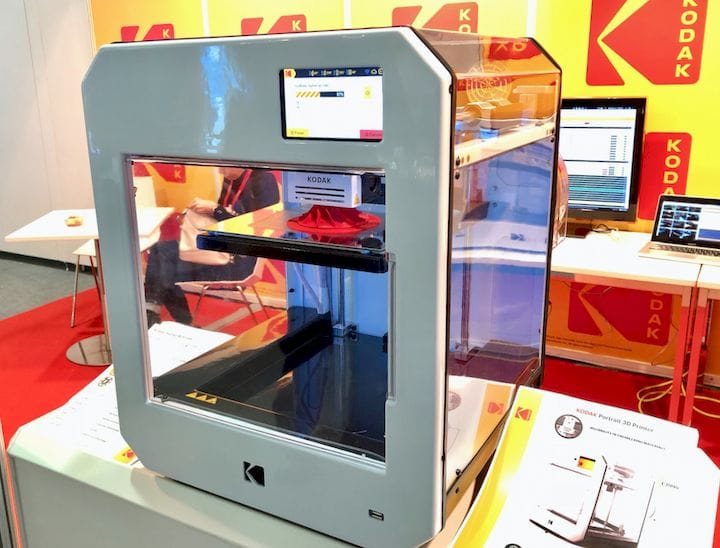![Kodak’s Portrait 3D printer has some new features [Source: Fabbaloo]](https://fabbaloo.com/wp-content/uploads/2020/05/image-asset_img_5eb0a1b939a8c.jpg)
We hadn’t heard much from Kodak on their new 3D printer for quite a while, but now they’re back in action.
We first saw their machine earlier this year at CES, where they showed their Portrait 3D printer. At that time we noted that the machine included a number of fascinating features that were designed to make life much easier for the operator, such as their tilting dual nozzle that helps avoid collisions during 3D printing.
We’re told they’ve incurred a bit of a delay to obtain specific regulatory certifications for the equipment, which have now been completed. Now they’re fully ready to sell machines.
But in the interim they’ve jazzed up the machine with even more useful features, one of which is quite unique.
![A successful ABS 3D print of an object with pathological geometry by the Kodak Portrait 3D printer [Source: Fabbaloo]](https://fabbaloo.com/wp-content/uploads/2020/05/image-asset_img_5eb0a1b9926d9.jpg)
The machine is now fully enclosed, meaning it is able to easily capture stray heat from the heated print surface to raise the ambient temperature in the print chamber. This will greatly help 3D printing certain warpy materials such as ABS.
![Screenshot of the Kodak 3D printing cloud [Source: Fabbaloo]](https://fabbaloo.com/wp-content/uploads/2020/05/image-asset_img_5eb0a1b9dea0c.jpg)
The machine now hooks up to the Kodak cloud service that can, for example, queue up print jobs, slice in the cloud, store GCODE files for future re-prints and monitor live print operations with the embedded camera in the Portrait 3D printer. The cloud service is based in Microsoft Azure, and we believe is actually a variant of 3DPrinterOS.
But the final improvement is quite unique: they’ve outfitted the dual E3D-Online hot ends differently. One hot end has a PTFE feed tube, while the other is entirely made of metal.
Why do this?
![Flexible Nylon 6 3D print produced on the Kodak Portrait [Source: Fabbaloo]](https://fabbaloo.com/wp-content/uploads/2020/05/image-asset_img_5eb0a1ba3a63a.jpg)
The PTFE nozzle is ideal for softer materials, and in particular for flexible filaments like TPU. These must be printed at far lower speeds than typical rigid filaments and would incur too much friction while passing through all-metal nozzles.
Meanwhile the other nozzle is all-metal, meaning it can be heated to very high temperatures. PTFE nozzles have a temperature limit because PTFE material will begin to break down at around 260C – and emitting some nasty chemicals in the process. Thus Kodak has made their second hot end capable of 3D printing high-temperature materials.
![Control panel on the Kodak Portrait 3D printer monitoring a nylon 3D print [Source: Fabbaloo]](https://fabbaloo.com/wp-content/uploads/2020/05/kodak-update-panel-1_result_img_5eb0a1ba82726.jpg)
Both of these hot end scenarios are well known. However Kodak has implemented BOTH in the same machine. This means that if you, for example, want to print TPU today, you merely print it on nozzle 1. You do not need to take apart the machine to swap nozzles, as is done in many other 3D printers. Similarly, the second nozzle is ready for printing high-temperature materials anytime without requiring hardware changes.
![It’s load and go on the Kodak Portrait 3D printer for either flexible or high temperature materials [Source: Fabbaloo]](https://fabbaloo.com/wp-content/uploads/2020/05/image-asset_img_5eb0a1bad8d68.jpg)
That’s a huge convenience feature for 3D printer operators that we have not seen previously. It’s actually quite a simple idea and I’m wondering why it hasn’t been a more popular approach.
Kodak also explained their warranty program. For US$400 per year, you will receive a FOUR year warranty on the equipment. This is perhaps one of the longest warranties available in the entire world of 3D printing, and it’s not that expensive. The warranty includes an annual “check up” at their now numerous service partners.
Kodak tells us the machine is now available from “many resellers across USA, Canada and Europe”.
That’s the power of a brand like Kodak.
Via Kodak 3D Printers











FELIXprinters has released a new bioprinter, the FELIX BIOprinter, which is quite a change for the long-time 3D printer manufacturer.